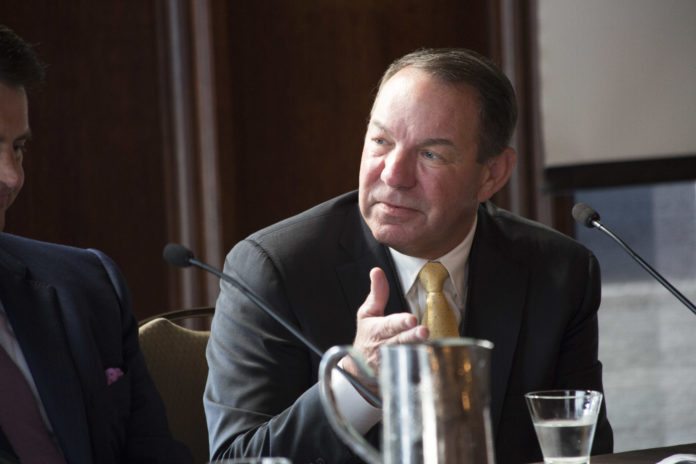In its latest report to Congress, the Medicare Payment Advisory Commission (MedPAC) recommended cutting the home health reimbursement rate by 5% in 2020 while continuing its push for a unified, site-neutral payment system for all post-acute care providers.
Those recommendations are short-sighted and fail to recognize the value that home health care providers have created in keeping patients at home and away from costlier settings, often with better outcomes, LHC Group (Nasdaq: LHCG) CEO Keith Myers told Home Health Care News.
Additionally, he said, the fact that MedPAC is pushing for both a rate cut and unified payment mechanism while the industry simultaneously moves toward the Patient-Driven Groupings Model (PDGM) shows just how out of touch MedPAC actually is.
“To cut the industry at a time where we’re already going through PDGM, when we’re having discussions about moving to a site-neutral model, it seems like MedPAC is off on some island, unaware of the policy movements that are being made,” said Myers, who also serves as chairman of the Washington, D.C.-based Partnership for Quality Home Healthcare (PQHH).
MedPAC is required to report to Congress each March on the Medicare fee-for-service (FFS) payment system, the Medicare Advantage program and the Medicare prescription drug program. In part, it made its recommendation to cut the home health payment rate by 5% in 2020 because of high operating margins the industry has achieved in the past.
In 2017, freestanding home health agencies’ average profit margin — or the rate at which Medicare payments exceeded providers’ marginal costs — was 17.5%, according to MedPAC, which noted in its report that a 5% reduction may not be enough to balance the financial equation.
“An immediate reduction of 5% in 2020 would represent a significant action to address the magnitude of the overpayments embedded in Medicare’s rates,” MedPAC officials wrote. “However, this reduction will likely be inadequate to align Medicare payments with providers’ actual costs, and further reductions will likely be necessary.”
Home health value not being recognized
Since launching in 2010, PQHH has worked in tandem with the National Association for Home Care & Hospice (NAHC), consultants and other industry groups to collect data supporting the value of home health care.
In general, that data has shown home health providers are achieving quality results at a fraction of the cost, an important point that MedPAC often overlooks, according to Myers. In some of Lafayette, Louisiana-based LHC Group’s markets, for example, the home health giant has been able to reduce skilled nursing facility (SNF) utilization by more than 50%.
“We’re creating value that’s not being scored and recognized,” Myers said. “The recommendations that have come out of MedPAC for years have been so one-sided and not complete.”
NAHC President William A. Dombi echoed similar concerns to HHCN when MedPAC released its latest report last Friday.
MedPAC previously recommended cutting the home health payment rate by 5% for 2019 and 2018 as well.
In addition to overlooking home health’s value, MedPAC may also be largely underestimating PDGM’s potential impact.
Although the payment overhaul is mandated to be budget neutral under the Bipartisan Budget Act of 2018, certain provisions could pose a 6.42% rate cut for providers. Upon implementation of PDGM, for example, CMS assumes that home health agencies will automatically change documentation and coding practices to put the highest-paying diagnosis code as the principal diagnoses code in order to have a 30-day period placed into a higher-paying clinical group.
Additionally, CMS believes agencies will take advantage of changes to co-morbidity coding and Low Utilization Payment Adjustment (LUPA) thresholds.
“Preparing for this new payment system presents unique challenges, more so for even smaller and mid-sized home health agencies and rural home health providers, where patients tend to be sicker and have greater challenges,” Myers said.
Senators Susan Collins (R-Maine), John Kennedy (R-La.), Bill Cassidy (R-La.), Rand Paul (R-Ky.), Debbie Stabenow (D-Mich.), Doug Jones (D-Ala.) and Jeanne Shaheen (D-N.H.) introduced legislation in February aimed at refining PDGM to revise those aforementioned provisions.
“Nearly identical” companion legislation will be introduced in the House within the next few weeks, spearheaded by Rep. Terri Sewell, an Alabama democrat, Myers said.
A unified payment model
MedPAC must report to Congress, but Congress and policymakers aren’t required to listen to what the commission has to say.
While that’s true, MedPAC’s findings can potentially help sway newer members of Congress who aren’t familiar with its work, meaning the home health industry can’t afford to turn a blind eye to its recommendations.
“Some dismiss MedPAC recommendations completely, others look at it like something there may be some truth in, but it’s not the complete picture. That would be the most positive of light that MedPAC is seen in,” Myers said. “But really anyone who makes these kinds of statements, we can’t just let them go without a response.”
Payment reductions aside, a unified payment system for all post-acute providers may be a boon for home health care if the timing and structure was appropriate, Myers added.
The idea itself may not be a bad one — it just doesn’t make sense alongside PDGM, the most significant overhaul to the home health industry in roughly two decades.
A unified post-acute care payment system would theoretically replace the four independent models currently used for SNFs, in-patient rehabilitation facilities, long-term care hospitals and home health care.
“We support the unified payment model,” Myers said, speaking from his PQHH position. “If we went to a truly site-neutral model, it would be the greatest win for the home health industry — if structured in the right way. And it would be a win for all payers, including taxpayers and the Medicare trust fund.”
In 2017, FFS program spending on post-acute care services totaled $58.5 billion, according to MedPAC.
Companies featured in this article:
LHC Group, MedPAC, National Association for Home Care & Hospice, Partnership for Quality Home Healthcare




